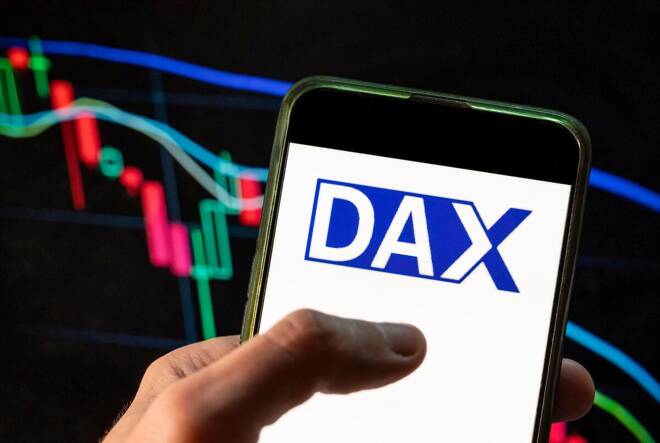Advertisement
Advertisement
DAX in the Hands of ECB and FED Speakers Ahead of the US CPI Report
By:
It is a quiet start to the week for the DAX. There are no European or US economic indicators to draw interest. China inflation numbers will set the tone.
Highlights
- It was a bullish end to a bearish week for the DAX. On Friday, the DAX gained 0.48% to end the day at 15,603.
- The US Jobs Report delivered much-needed relief, though US wage growth figures capped the upside.
- A quiet Monday session will leave central bank chatter to influence. Inflation numbers from China set the tone.
It was a bullish Friday session for the DAX, which rose by 0.48%. Partially reversing a 2.57% loss from Thursday, the DAX ended the week down 3.37% to 15,603. Significantly, the DAX visited sub-15,500 for the second time since April 5.
It was a quiet start to the day, with no economic indicators from China to set the tone. However, industrial production numbers from Germany drew interest, with production unexpectedly falling in May. However, the devil was in the details, with the report supporting auto stocks.
Late in the session, the US Jobs Report failed to have the same impact as the ADP report, with the DAX holding onto modest gains despite unwavering bets on a July Fed interest rate hike. The NASDAQ Composite Index fell by 0.13%, with the Dow and S&P 500 seeing losses of 0.55% and 0.29%, respectively.
According to the CME FedWatch Tool, the probability of a 25-basis point July Fed rate hike was 93.0% versus 86.8% one week earlier. Significantly, the chances of the Fed lifting rates to 5.75% in September stood at 24.2%, up from 20.8% one week earlier.
German Industrial Production Delivered Support
It was a busy Friday session, with economic indicators from Germany and the US in the spotlight.
German industrial production numbers failed to spook investors. Industrial production fell by 0.2% in May versus a 0.3% increase in April. Economists forecast production to stall. Investors looked beyond the headline figure, with a pickup in vehicle, trailers, & semi-trailer production providing comfort.
- The manufacture of basic pharma products and preparations tumbled by 13.1%, with energy production down 7.0%.
- However, the manufacture of motor vehicles, trailers, & semi-trailers jumped by 4.9%.
- Production in industry excluding energy and construction rose by 0.2%.
After US ADP nonfarm employment change numbers from Thursday, the all-important US Jobs Report failed to deliver fireworks.
In June, nonfarm payrolls increased by 209k. Nonfarm payrolls rose by 306k in May. Significantly, average hourly earnings were up 4.4% versus 4.4% in May, suggesting the need for more Fed action. There was little movement in Fed bets following the US Jobs Report, despite the weaker NFP number.
In contrast, the ADP reported a 497k surge in nonfarm employment on Thursday.
The Market Movers
It was a mixed Friday session for the auto sector. BMW fell by 0.81% to buck the trend. However, Porsche and Continental AG saw gains of 1.81% and 1.27%, respectively. Mercedes-Benz Group and Volkswagen also found support, rising by 0.74% and 0.82%, respectively.
It was a bullish session for the banks. Commerzbank and Deutsche Bank ended the day up 2.59% and 2.14%, respectively.
The Day Ahead for the DAX
Economic indicators from China set the tone this morning, with inflation in focus.
In June, China registered zero inflation in June, with consumer prices falling by 0.2%. Economists forecast consumer prices to remain unchanged and for the annual inflation rate to hold steady at 0.2%.
Significantly, the Producer Price Index garnered more interest as investors fret over the economic outlook. In June, the PPI fell by 5.4% year-over-year versus a 4.6% decline in May. Economists forecast a 5.0% decline, signaling a deteriorating demand environment.
It is a quiet day ahead on the European economic calendar. There are no euro area economic indicators to move the dial. The lack of economic indicators will leave central bank chatter to influence. However, with no ECB members on the calendar to speak today, investors should monitor commentary with the media.
It is also a quiet day on the US economic calendar. There are US economic indicators to provide direction.
After the recent labor market and service sector stats, FOMC member commentary will draw interest today. FOMC members Barr, Bostic, Daly, and Mester are on the calendar to deliver speeches. The talk of consecutive rate hikes in July and September would test buyer appetite.
Away from the economic calendar, updates on the US Treasury Secretary Janet Yellen visit to Beijing are bullish. Yellen reportedly said that 10 hours of meetings were direct and productive.
DAX Technical Indicators
Looking at the EMAs and the 4-hourly chart, the EMAs sent bearish signals. The DAX sat below the 50-day (15,926) and 200-day ($15,830) EMAs. The 50-day EMA closed in on the 200-day EMA, sending bearish signals.
A DAX move through the lower level of the 15,785 – 15,845 resistance band would bring the 200-day EMA (15,839) and the upper level of the 15,785 – 15,845 resistance band into view. However, central bank chatter needs to support a rebound.
Failure to move through the lower level of the 15,785 – 15,845 resistance band would leave the upper level of the 15,280 – 15,235 support band in view.
The 14-4H RSI sits at 31.02, sending bearish signals and supporting a further pullback to target the upper level of the 15,280 – 15,235 support range.
For a look at the economic events, check out our economic calendar.
About the Author
Bob Masonauthor
With over 28 years of experience in the financial industry, Bob has worked with various global rating agencies and multinational banks. Currently he is covering currencies, commodities, alternative asset classes and global equities, focusing mostly on European and Asian markets.
Advertisement
